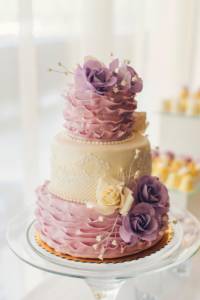Wedding Cake Trends for 2017

Common wedding cake trends seem to be drifting away from the traditional white cake and more towards making cakes more vibrant and fun with their colors.
The most common wedding cake trend seems to be moving more toward coordinating with the bride’s colors, even if there is no white on the cake. Here are some of the trends for cakes this year:
When most people think of a wedding cake, they automatically assume it should be white. There are a lot of reasons for this. White denotes purity, which became popular during the Victorian era. The white wedding cake is also a visual link between the bride and the cake. White cakes and frosting, at one time, symbolized affluence. It was difficult to get refined sugar before the Victorian age. The whiter the cake, the more wealth a family had to obtain those difficult ingredients.
Here are some of the cake trends for this year:
- Metallic decorations – think edible glitter for sparkle, or gold- or silver-leaf sheets in cutout embroidery lace-like designs.
- White on white – a traditional cake with only white decorations.
- Ruffles – no, not fabric ruffles, but embellishments of sugar frills. Include fresh or sugar flowers to finish off the cake.
- Naked cakes – show off the inside of a cake by not frosting it. Fill the layers with seasonal fruits or nuts to add texture and taste.
- Marbleized decorations – hand-painted designs on the frosting, set off with a simple ribbon or flower border.
- Stained-glass – these cakes are part of the hand-painted variety but include outlining the images in black.
- Beads – cover your cake with edible beads for a unique look.
- Greenery and botany – don’t limit your cake decorations to flowers, but use fruits and greenery or anything organic to make it your own.
- Navy and black – most people don’t associate navy blue or black with a wedding, but more brides are choosing one of these elegant colors as part of their attire.
- Whimsical cakes – more brides are forgoing the elegant white cake for a tiered cake that represents their personality.
- Ombre effect – blend colors on the wedding cake from a dark, deep tone to the lightest tint.
- A cake trio, or quartet – a table of cakes at your reception, giving your guests two to three flavors to choose from. Not only does this make for a spectacular display, but you won’t have to choose between your two favorite flavors.
- Rainbow cake – the inside of the cake is done in the colors of the rainbow, while the outside of the cake is more traditional.
- A “sweet” cake – cover your wedding cake in the candies or sweets you enjoy. Some brides are even creating cakes out of their favorite goodies, opting for a different type of dessert altogether.
- Monograms – decorate with your initials in a repetitive pattern around the cake. From a distance, it will be a pretty pattern. You could also have a sugar-made plaque with your new monogram.
- Buttercream cakes – instead of the smooth fondant layer on the cake, more brides are going with a simple buttercream frosting in a pattern that might not be perfect. It tastes much different than fondant and can feel more casual and relaxed.
Why Stacked Wedding Cakes?
In the Middle Ages, legend has it that cakes or buns would be stacked in a large pile before the newly wedded couple. The couple would then try to kiss each other over the stack, and if they could, it symbolized a lifetime of prosperity. Eventually, the layers of cake would be stacked together with frosting. Because modern refrigeration wasn’t available, the cakes would be covered with lard to keep them moist. The lard would be scraped off before serving, but invariably, a small amount of the lard could not be removed. Bakers began adding sugar to the lard to improve the taste, and thus, the modern wedding cake came into being.

